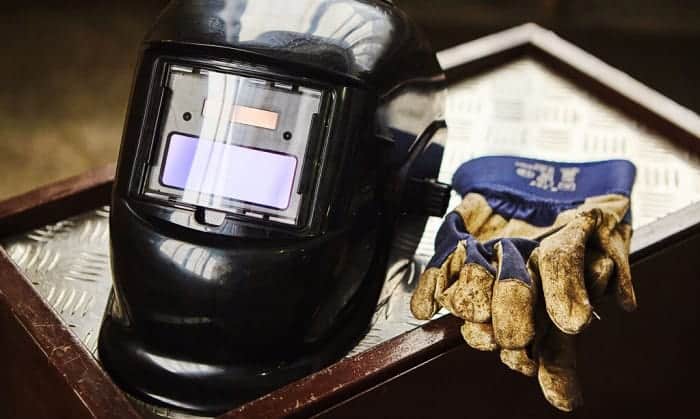While some Personal Protective Equipment (PPE) pieces are optional in welding tasks, some others are indispensable. Welding glasses and gloves are among the things that welders cannot do without when performing. Due to the harsh conditions of work, welders are required by ANSI Z49.1 to wear protective gloves that resist flame.
But that’s not the only hazard blocked by these gears. So, for the question “What do welding gloves protect against?”, please know that they keep welders safe from cuts, punctures, electric shocks, UV radiation, etc.
Table of Contents
Different Types of Welding Gloves and What Do Welding Gloves Protect Against
There are three main types of welders gloves designed for specific conditions and requirements of the welding tasks. We will go through how those gloves support workers and keep them safe during the process.
TIG Welding gloves
Since TIG welding generates a fair amount of heat with concentrated flame, there will be few sparks during the process. Hence, work gloves for TIG welders tend to be thinner than usual, offering more sensitivity for easy finger movements.
The glove dexterity is meant to protect us from losing control over the TIG torch. Besides, these pairs are usually manufactured and tested to meet ANSI heat protection level 2 and ANSI puncture-resistant level 3.
Also, some gauntlet welding gloves made for TIG welding are long enough to keep sparks from hurting our wrists. And they can come with palm paddings to dampen the vibration of the TIG torch.
In the collection of TIG welding gloves, we can see many quality pairs made of leather, including pigskin, cowdie, sheepskin, horsehide, and goatskin.
MIG welding gloves
The hazards from the MIG welding process include arc radiation, electricity, fumes. Also, welders have to protect themselves from inert gas, flame, and heat. So, these are what MIG welding gloves should shield them from.
Slightly thicker than TIG welding gloves, these pairs are made to be excellent at open flame and spark resistance. There is often an added foam padding and lining to ensure minimal hurt by intense heat, meeting ANSI heat resistance level 3.
The common materials used for MIG welding are suede leather, aluminum-treated leather, high tensile-strength goatskin, split cowhide, etc.
Arc/Stick welding gloves
For these welding tasks, the main dangers are burns, explosions, heat & radiation exposure, and electric shocks. So, wearing a suitable pair of stick weldings can shield us against such hazards.
While dexterity is essential for MIG and TIG welding, stick gloves focus more on protecting workers from thermal contact. So, they are often thicker than the above types, coming with extra padding and rugged Kevlar lining.
Some gloves come with aluminized backing to reflect most radiant heat from stick welding. These pairs can handle a temperature range from 5400°F to 36,000°F. Furthermore, stick welding gloves are often constructed out of cowhide or elk hide, as these leather fabrics can resist heat well.
How to Choose Suitable Welding Gloves to Protect Your Hands
- ANSI-certified gloves: The clues above about the qualifications for each type of glove should give you an idea about choosing the right one. Make sure the selected pair can handle the hazards of the welder tasks by checking its testing and certifications.
- Heat resistance: You can evaluate the amount of heat generated by certain welding tasks to purchase the right gloves. For welding torch 90 Amps or above, the gear should come with Kevlar lining.
Also, cotton and foam insulation are necessary for a higher level from 125 Amps – 250 Amps and above. If you are dealing with stick welding over 500 Amps, make sure to choose one with a protective backing.
- A good fit: For MIG and TIG welding, precision during tasks is essential. So, we need a glove that fits all fingers nicely while offering hand sensitivity. You can try on the gloves then flex your hands by holding a fist. If you go for long welding gloves, make sure the piece does not limit your wrist or thumb movements.
- Comfort: Besides all the protective features necessary to keep our hands safe. One important thing to pay attention to is the gloves’ inner layer that offers comfort for long hours. Also, the pair should come with moisture-wicking fabric that makes sure we feel breathable throughout the task.
FAQs About Welding Gloves
Can welding gloves prevent electric shock?
Yes, they can. Electric shocks are part of the danger that welders face when handling their tasks. Usually, the welding process can produce electricity with open voltages of around 20 to 100 V. If you use the welding machine, the voltages can reach over 575 V.
But wearing welding gloves does not protect us entirely from this hazard. So, we have to be geared with suitable shoes, helmet, and suit to keep us from getting electric shocks.
Are welding gloves cut-resistant?
Yes, they are. We need a rugged glove when dealing with sharp instruments or objects made of ceramics, metals, and glass, which are prevalent in the welding process. Cut-resistant gloves are constructed with a Kevlafiber line to ensure sharp tools will not hurt us.
Conclusion
So, hopefully, you already found the answer to the burning question “What do welding gloves protect against?” when finishing our article. Our guide should help you better understand the necessity of this gear for welders. Furthermore, if you want to purchase a good pair, this article might be a good start with helpful clues. Good luck!

Hi, I am Alexander, forty-seven years old this year. I have been in the construction industry for twenty-five years and have provided a wide range of services. When it comes to expert guidance on site safety gear, you can put your trust in me.




